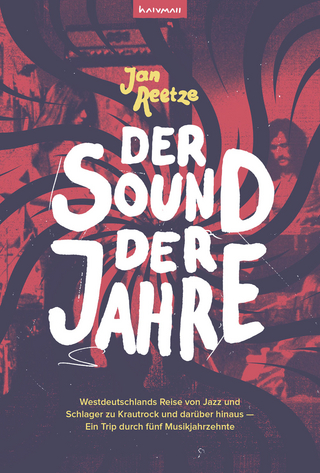
The Literary Taylor Swift
Bloomsbury Publishing USA (Verlag)
979-8-7651-0451-4 (ISBN)
Although Swift is a perennial subject in the media, cast in both a positive and a negative light, few professional scholars have considered her ever-growing body of work. The Literary Taylor Swift examines Swift’s significance and timeliness through through literary analysis and theory.
The ability to craft immersive narratives and to articulate, with acuity, a broad range of emotional experiences and a profound relationship with text is one of Taylor Swift's hallmarks. The Literary Taylor Swift explores Swift’s engagements, intertextual and otherwise, with literature and treats her songs as literature. Literature as in stories, poems, and other textual forms to which literary-critical theories and methodologies can and should be productively applied. Swift's many self-styled characters are analyzed with and against literary figures and literature, from Swift's focus on reputation as read alongside 18th-century women writers to the crazy ex-girlfriend trope as feminist resistance and Swift's self-fashioned renaissance through folklore (2020) and evermore (2020). This collection offers carefully curated arguments constellated around four key relationships: Swift and the literary-historical canon; Swift and the language of gender and sexuality; Swift and the relationship between writing and memory; and Swift and the nature of literary craft.
Betsy Winakur Tontiplaphol is Professor of English at Trinity University in San Antonio, Texas, USA, where she specializes in 19th-century British literature, particularly Romantic poetry. In addition to numerous essays, she is the author of Poetics of Luxury in the Nineteenth Century: Keats, Tennyson, and Hopkins (2011) and The Pointe of the Pen: Nineteenth-Century Poetry and the Balletic Imagination (2021). Anastasia Klimchynskaya is an instructor in the School of Communication at Loyola University Chicago, Illinois, USA. She specializes in 19th-century literature in its intersections with science, technology, and the cultural imagination. She is author of a forthcoming volume on the emergence of science fiction as a reflection of humanity's recalibrated relationship to the natural world. Her work has appeared in Configurations, the SFRA Review, Social Anthropology, and SF Film and Television.
Introduction: Blank Spaces, Fresh Pages: Taylor Swift and/as Literature
Betsy Tontiplaphol, Trinity University, USA, and Anastasia Klimchynskaya, Loyola University Chicago, USA
Part 1: All of the Books Beside Your Bed: Engaging the Literary-Historical Canon
1. “I haven’t met the new me yet”: folklore/evermore and Taylor Swift’s Self-Fashioned Renaissance
Devori Kimbro, University of Tennessee at Chattanooga, USA
2. Big Reputation: Reading Taylor Swift and/with 18th-Century Women Writers
Bridget Donnelly, Middle Tennessee State University, USA
3. “Just to break me like a promise”: Taylor Swift as Romantic Heroine
Rita J. Dashwood, Edge Hill University, UK
4. “What are my Wordsworth?”: Taylor Swift’s New Romanticism
Brittany Reid, Thompson Rivers University, Canada, and Taylor McKee, Brock University, Canada
5. Baby, We're the Late Romantics: Taylor Swift and the English Biedermeier
Betsy Winakur Tontiplaphol, Trinity University, USA
6. Modernist Intertextualities in folklore and evermore
Jennifer Smith, North Central College, Illinois, USA
Part 2: Every Version of Yourself Tonight: Examining Gender, Sexuality, and Race
7. The Death of the Pop Auteur: Taylor Swift’s Feminist Politics of Collaboration and Revision
Stephen Grandchamp, University of Maine at Farmington, USA
8. “No one likes a mad woman”: The Crazy Ex-Girlfriend Trope and/as Feminist Resistance in Taylor Swift’s Music and Mythology
Ryanne Kap, University of Calgary, Canada
9. Female Millennial Rage: The Weaponization of Cottagecore
Katherine Murray, Independent Scholar
10. “She would’ve made such a lovely bride”: Queer Anxieties on folklore and evermore
Erin Geary, Independent Scholar
11. What It Means to Shake It Off: Taylor Swift, Race, and Citizenship
Shaun Cullen, Independent Scholar
Part 3: Time, Curious Time: (Re-)Writing Memory
12. “Time, curious time”: Memory, Agency, and Elastic Temporality in Taylor Swift
Miranda Steege, University of California, Riverside, USA
13. “Say you’ll remember me… all too well”: Taylor Swift’s Mobilizing and Monopolizing Memory Work
Maggie Boyd, Boston University, USA
14. “Scrap[s] of you”: Textures of Loss in Swift’s folklore and evermore
Claire Hurley, University of Kent, UK
15. What They Did Was Just as Dark: The Traumatic and the Unspoken in Taylor Swift’s Post-Hiatus Era
Carolin Isabel Steiner, Hochschule Mittweida, Germany
Part 4: This Ain’t a Fairy Tale: Considering Craft, Genre, and Mediation
16. Show, Don’t Tell? How Taylor Swift Does Both and Complicates a Writing Cliché
Samantha Bañal, Independent Scholar
17. "I never knew I could feel that much": Taylor Swift's Recuperative Aesthetics of Excess
Anastasia Klimchynskaya, Loyola University Chicago, USA
18. The Paradox of Defamiliarization and Hyperfamiliarity in Taylor Swift’s Songwriting
Margrét Ann Thors, University of Iceland
19. “This is me trying”: Autofiction and Taylor Swift
Maria Juko, University of Hamburg, Germany
20. (Taylor’s Version): Authenticity and Aura in Taylor Swift’s Re-Recordings
Meghan Kuehnle, The Ohio State University, USA
Contributors
Index
| Erscheinungsdatum | 29.10.2024 |
|---|---|
| Verlagsort | New York |
| Sprache | englisch |
| Maße | 152 x 229 mm |
| Themenwelt | Kunst / Musik / Theater ► Musik ► Pop / Rock |
| Geisteswissenschaften ► Sprach- / Literaturwissenschaft ► Anglistik / Amerikanistik | |
| Geisteswissenschaften ► Sprach- / Literaturwissenschaft ► Literaturwissenschaft | |
| ISBN-13 | 979-8-7651-0451-4 / 9798765104514 |
| Zustand | Neuware |
| Haben Sie eine Frage zum Produkt? |
aus dem Bereich


